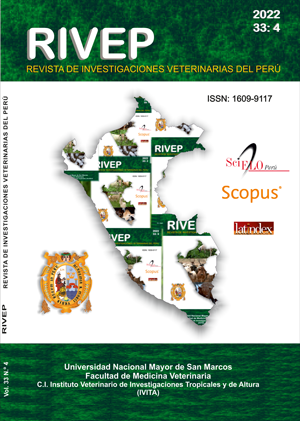Morphological and histological characteristics of ovaries from two genetic groups of guinea pigs (Cavia porcellus) from South America
DOI:
https://doi.org/10.15381/rivep.v33i4.23349Keywords:
guinea pigs, ovary morphology, follicles, oocytesAbstract
This study aimed to describe morphological and histological characteristics of ovaries of two genetic groups of guinea pigs from Latin America. Ovaries from 20 improved and 20 native guinea pigs were collected after slaughtering. One ovary from each animal was weighed, measured, counted for visible follicles on the ovarian surface, and used for subsequent oocyte collection by the slicing method. Contralateral ovaries were used to prepare histological sections and quantify follicles. Body and ovary weight and ovary length were significantly greater in improved than in native guinea pigs (p<0.01). Ovarian weight was greater in diestrus than in proestrus (p=0.0632) only in improved animals. The number of primordial, primary, secondary, and total follicles did not differ between genetic groups. The number of antral follicles was significantly greater in improved than in native guinea pigs. The thickness of zona pellucida and oocyte diameter did not differ between groups. The thickness of the zona pellucida was significantly greater in oocytes of category A than B and C in both groups of guinea pigs. In conclusion, ovaries from improved guinea pigs were heavier and longer than those from native animals. The number of antral follicles was greater in improved than native guinea pigs. Zona pellucida thickness and oocyte diameter were similar in both groups of guinea pigs.
Downloads
Downloads
Published
Issue
Section
License
Copyright (c) 2022 Estefanía A. Fernández, Cornelio A. Rosales, Juan P. Garzón, Daniel E. Argudo, Luis E. Ayala, Guillermo E. Guevara, Jaime E. Maldonado, Fernando P. Perea

This work is licensed under a Creative Commons Attribution 4.0 International License.
AUTHORS RETAIN THEIR RIGHTS:
a. Authors retain their trade mark rights and patent, and also on any process or procedure described in the article.
b. Authors retain their right to share, copy, distribute, perform and publicly communicate their article (eg, to place their article in an institutional repository or publish it in a book), with an acknowledgment of its initial publication in the Revista de Investigaciones Veterinarias del Perú (RIVEP).
c. Authors retain theirs right to make a subsequent publication of their work, to use the article or any part thereof (eg a compilation of his papers, lecture notes, thesis, or a book), always indicating the source of publication (the originator of the work, journal, volume, number and date).



